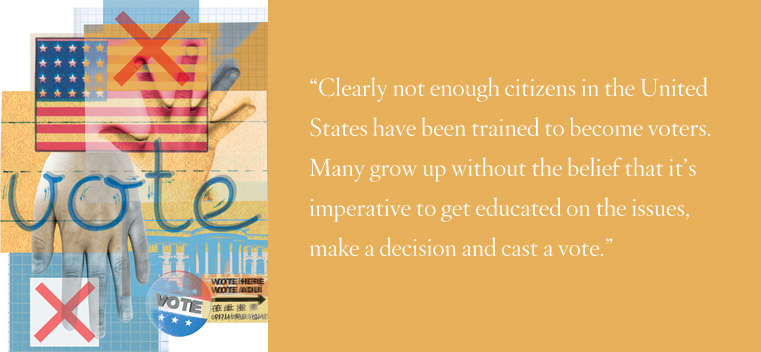
Vote Early — And Often
The best way to get U.S. citizens to participate on Election Day is to teach children about voting.
When my children were young, I tried to make Election Day special, like a holiday. After school we all trooped over to our polling place in Chatham, N.J., and the kids came with me into the voting booth. They took turns pushing the buttons I told them to push, then they’d argue over who got to press the final “Cast Vote” button on the electronic voting machine. The poll workers gave them “I voted today” stickers, which they wore proudly, and at dinner we’d have a toast to congratulate ourselves for participating in our political process.
According to the U.S. Census Bureau, only 58 percent of the population eligible to vote in this country actually exercised that right in the 2008 presidential election. In 2010 only 42 percent took the time to choose their representative in the U.S. House. Compared with many other countries, these rates are anemic. Clearly not enough citizens in the United States have been trained to become voters. Many grow up without the belief that it’s imperative to get educated on the issues, make a decision and cast a vote. Unfortunately, I see nothing happening to suggest that the situation will change with the next generation.
I concede that politics is a passion of mine, and we probably have a more politically oriented household than most. I’ve served on my party’s local committee, and my husband and I like to talk about national races (causing my daughter to leave the room a lot when she was little because she didn’t want to hear about pol-IT-ics again). I was also campaign manager for candidates running for my local council and then mayor. Somehow we pulled off a huge upset victory both times, so the kids got to go to the victory parties. Last year I became a poll worker for the first time, and I acquired a new appreciation for what it takes to make an election run smoothly. But even if you don’t have that much passion for politics, impressing upon children the need to vote is a lesson that parents everywhere should be teaching. Since 2012 is a presidential election year, now is the perfect time to start.
Here are some suggestions for producing future voters:
• Take the kids with you when you vote to get them in the habit. At poll worker training I learned that inside the booth you should keep the kids on the side opposite the “Cast Vote” button, especially if they are young, so they don’t accidentally push that button before you’re finished.
• At the site in Madison, N.J., where I served as a poll worker, some of the veteran poll workers brought leftover Halloween candy. Even if that doesn’t happen at your polling site, dole out treats to your kids as a reward for voting.
• When your children turn 18, make sure they register to vote. This is a milestone in their lives. Celebrate it.
• Confirm that your teenagers vote, even if they are at college. They can vote by mail if they can’t get to the polls.
• Talk to your children about what’s going on in Washington, D.C., your state capital, your town hall. Many of the decisions being made today are going to affect them, and understanding the basics of an issue will make them more likely to want to participate and more interested in seeing if their candidates win. Some issues may be difficult for them to grasp, but all kids understand winning and losing. If your candidates win, have a special dinner. Win or lose, talk about what the outcome likely means.
• If you can influence editorials in your area, do something more creative than trot out a tired appeal urging people to vote. In towns where there is more than one elementary school, try cross-referencing the list of those who voted in the last election with the addresses in each school district. Then publish the numbers to show which school district had the highest percentage of voters. Nothing eliminates inertia like competition between schoolchildren. Of course, not everyone who failed to vote in the district will be a parent at the school, but having your kids nag you to vote so their school might win bragging rights in the local paper/website is a sure-fire way to increase the percentage of parents who take the time to do it. At the same time, it makes voting important to the next generation.
My son turned 18 in summer 2011, and he voted for the first time last November. This year will be his first presidential election. I hope that I have imparted the virtues of my party to him, but even if he decides to vote for the other team, the important thing is that he votes.



 Facebook
Facebook Twitter
Twitter Email
Email


